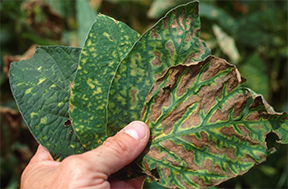Sudden Death Syndrome
Sudden Death Syndrome
Symptoms
Sudden death syndrome (SDS) usually develops in "hot spots" in a field and then progresses to the remainder of

Range of Sudden Death Syndrome foliar symptoms
University of Kentucky Dept. Plant Pathology
the field. Affected plants develop symptoms about the mid pod-fill stage of development. Symptoms get progressively worse until the plants die.
Foliar symptoms will first appear as random, irregularly shaped yellow blotches between the veins of leaves. The blotches can start at any level in the canopy of plants. As the disease progresses, blotches run together and tissue between the veins dies, but the veins remain green. Diseased leaves may be distinctly curled due to excessive drying of diseased tissue. Infected leaflets drop from plants, but the leaf petioles usually remain attached to the plant. Severe defoliation in the early to mid-reproductive stages may be accompanied by flower and pod abortion and dropping of developing pods. Fully expanded pods, although they may ripen prematurely, rarely fall off the plant.
In addition to foliar symptoms, plants with sudden death syndrome (SDS) will also show characteristic symptoms of the roots and stems. Root symptoms will be present before foliar symptoms and appear as a general deterioration of taproots and lateral roots. Nitrogen-fixing nodules, present on the soybean roots, deteriorate and are non-functional. The internal portion of affected taproots will turn a milky gray-brown. This general discoloration will extend up the stem for several nodes, but the stem core remains a healthy color of white.
SDS appears to be most common in fields with high soil fertility and a soybean cyst nematode problem.
Cause
Sudden death syndrome (SDS) is caused by a strain of the common soil fungus Fusarium solani (FS-A). Although FS-A is the primary organism associated with SDS, other pathogens may also be involved in disease development.
SDS symptoms are the result of root infections by FS-A. The fungus cannot be isolated from plant tissue above the soil line, which suggests that foliar symptoms may be the result of a fungus-produced toxin. The fact that plants occasionally recover after showing earlier foliar symptoms suggests toxin action, however, any toxin's role in SDS development has not yet been proven.
Researchers in Mississippi confirmed a link between soil moisture and SDS. They found that root infection by FS-A was highest and SDS more severe under conditions of continuous, high soil moisture during the early vegetative stages of crop development.
IPM Techniques
- Fields should be observed for SDS every two weeks from pod fill until maturity.
- At each site, examine two rows of plants 20 feet in length and keep an eye out for any suspicious areas within the field.
- The number of random sites, you should observe is based on the size of the field.
- View the chart of field size and number of locations for the number of sites.
- SDS can be detected from a considerable distance.
The following practices, in an integrated approach, should help reduce the overall impact of SDS.
- Plant cultivars which have performed well in the presence of SDS.
- Plant more than one cultivar, preferably from different maturity groups.
- For full season soybeans, delay planting for as long as possible. Early May plantings are at generally higher risk than are late May/early June plantings.
- Plant parts of fields or different cultivars at different times.
- Use cultural practices wich reduce plant stress such as good fertility and weed control.
- Improve drainage of field.
- Harvest affected fields in a timely fashion.
References and Additional Information
- IPM-3 Kentucky IPM Manual for Soybeans
- PPA-10b Kentucky Plant Disease Management Guide for Soybean by D.E. Hershman, Extension Plant Pathologist
- PPA-37 Soybean Sudden Death Syndrome in Kentucky by Don E. Hershman, Extension Plant Pathologist
- Compendium of Soybean Diseases, J.B. Sinclair and P. A. Backman (The American Phytopathological Society Press)


